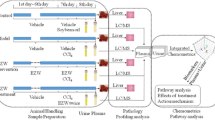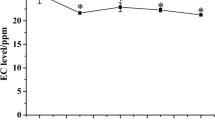Abstract
Amino acids (AA) play a crucial role in the metabolic process of animals, plants and microbial cells, which are useful for the diagnosis, follow-up and prognostics of liver disorders affecting AA metabolism. A rapid, simple and sensitive analytical method is in urgent need to investigate the intact metabolic profile and to simultaneously determine individual AA in biological samples. Here, a hydrophilic interaction liquid chromatography (HILIC) coupled with tandem mass spectrometry (MS/MS) analytical method was developed and validated for simultaneous quantification of 15 AA in rat serum using isotope stable-labeled phenylalanine and alanine as internal standards. The 15 AA without derivatization were separated on a hydrophilic interaction silica column (TSK-GEL AMIDE-80), the total analytical time was within 8 min, and the concentrations of the 15 AA were determined using a multiple reaction monitoring (MRM) mode. Limits of detection (LOD) ranged from 0.01 to 0.05 μg/ml, and the calibration curve was linear in the range of 0.05–10 μg/ml (r > 0.99). The HILIC-MS method was employed to the analysis of AA in serum samples obtained from N-acetyl-p-amino-phenol (APAP)- and chloropromazine hydrochloride (CH)- induced liver injured rats. The concentrations of each AA ranged from the low quantification value up to 10 μg/ml. Based on metabolic profile of AA, multivariate statistics using principal component analysis (PCA) and partial least squares discriminate analysis (PLS-DA) could differentiate two distinct groups corresponding to APAP-induced and CH-induced rats. This novel metabolic profile study of AA based on the HILIC-MS analysis and chemometric analysis provided not only an accurate quantitative assay of the serum concentrations of biomarkers, but also a promising methodology for evaluation of chemical-induced hepatotoxicity in reflecting AA metabolic pathway.




Similar content being viewed by others
Abbreviations
- AA:
-
Amino acids
- HILIC:
-
Hydrophilic interaction liquid chromatography
- MS/MS:
-
Tandem mass spectrometry
- MRM:
-
Multiple reaction monitoring
- APAP:
-
N-acetyl-p-amino-phenol
- CH:
-
Chloropromazine hydrochloride
- IEX-LC:
-
Ion exchange chromatography
- HPLC–MS:
-
High performance liquid chromatography-mass spectrometry
- GC–MS:
-
Gas chromatography-mass spectrometry
- PPT:
-
Protein precipitation
- PCA:
-
Principal component analysis
- PLS-DA:
-
Partial least squares discriminate analysis
- VIP:
-
Variable importance in the projection
- IS:
-
Internal standard
- Phe:
-
Phenylalanine
- Trp:
-
Tryptophan
- Tyr:
-
Tyrosine
- Leu:
-
Leucine
- Ile:
-
Isoleucine
- Val:
-
Valine
- Met:
-
Methionine
- Pro:
-
Proline
- His:
-
Histidine
- Asn:
-
Asparagine
- Arg:
-
Arginine
- Thr:
-
Threonine
- Ala:
-
Alanine
- Gln:
-
Glutamine
- Lys:
-
Lysine
- CMC-Na:
-
Sodium carboxymethyl cellulose
- i.g.:
-
Oral administration
- i.p.:
-
Intra-peritoneal
- ALT:
-
Alanine aminotransferase
- AST:
-
Aspartate aminotransferase
- ALP:
-
Alkaline phosphatase
- ALB:
-
Albumin
- TBIL:
-
Total bilirubin
- QC:
-
Quality control samples
- LOQ:
-
Low limit of quantification
- LOD:
-
Limit of detection
- RSD:
-
Relative standard deviation
- BCAA:
-
Branched chain amino acids
- AAA:
-
Aromatic amino acids
References
Gandhi, A., Guo, T., & Ghose, R. (2010). Role of c-Jun N-terminal kinase (JNK) in regulating tumor necrosis factore-alpha (TNF-a) mediated increase of acetaminophen (APAP) and chlorpromazine (CPZ) toxicity in murine hepatocytes. The Journal of Toxicological Sciences, 35, 163–173.
Goodacre, R., Broadhurst, D., Smilde, A., Kristal, B. S., Baker, J. D., Beger, R., et al. (2007). Proposed minimum reporting standards for data analysis in metabolomics. Metabolomics, 3, 231–241.
Grumbach, E. S., Diehl, D. M., & Neue, U. D. (2008). The application of novel 1.7 μm ethylene bridged hybrid particles for hydrophilic interaction chromatography. Journal of Separation Science, 31, 1511–1518.
Hinson, J. A., Bucci, T. J., Irwin, L. K., Michael, S. L., & Mayeux, P. R. (2002). Effect of inhibitors of nitric oxide synthase on acetaminophen-induced hepatotoxicity in mice. Nitric Oxide: Biology and Chemistry, 6, 160–167.
Holecek, M., Mraz, J., & Tilser, I. (1996). Plasma amino acids in four models of experimental liver injury in rats. Amino Acids, 10, 229–241.
Holt, M. P., & Ju, C. (2006). Mechanisms of drug-induced liver injury. The AAPS Journal, 8, E48–E54.
Hutson, S. M., Sweatt, A. J., & LaNoue, K. F. (2005). Branched-chain amino acid metabolism: Implications for establishing safe intakes. The Journal of Nutrition, 135, 1557S–1564S.
Huub Waterval, W., Scheijen, J., Oetmans-Ploemen, M., Habets-van der Poel, C., & Bierau, J. (2009). Quantitative UPLC-MS/MS analysis of underivatised amino acids in body fluids is a reliable tool for the diagnosis and follow-up of patients with inborn errors of metabolism. Clinica Chimica Acta, 407, 36–42.
Kanno, S., Tomizawa, A., Hiura, T., Osanai, Y., Kakuta, M., Kitajima, Y., et al. (2006). Melatonin protects on toxicity by acetaminophen but not on pharmacological effects in mice. Biological and Pharmaceutical Bulletin, 29, 472–476.
Kaspar, H., Dettmer, K., Chan, Q., Daniels, S., Nimkar, S., Daviglus, M. L., et al. (2009). Urinary amino acid analysis: A comparison of iTRAQ-LC-MS/MS, GC-MS, and amino acid analyzer. Journal of Chromatography B, 877, 1838–1846.
Liang, X. P., Liang, Q. L., Xia, J. F., Wang, Y., Hu, P., Wang, Y. M., et al. (2009). Simultaneous determination of sixteen metabolites related to neural tube defects in maternal serum by liquid chromatography coupling with electrospray tandem mass spectrometry. Talanta, 78, 1246–1252.
Lozanov, V., Benkova, B., Mateva, L., Petrov, S., Popov, E., Slavov, C., et al. (2007). Liquid chromatography method for simultaneous analysis of amino acids and biogenic amines in biological fluids with simultaneous gradient of pH and acetonitrile. Journal of Chromatography B, 860, 92–97.
McCalley, D. (2007). Is hydrophilic interaction chromatography with silica columns a viable alternative to reversed-phase liquid chromatography for the analysis of ionisable compounds? Journal of Chromatography. A, 1171, 46–55.
McCalley, D., & Neue, U. D. (2008). Estimation of the extent of the water-rich layer associated with the silica surface in hydrophilic interaction chromatography. Journal of Chromatography. A, 1192, 225–229.
Shen, X., Deng, C., Wang, B., & Dong, L. (2006). Quantification of trimethylsilyl derivatives of amino acid disease biomarkers in neonatal blood samples by gas chromatography-mass spectrometry. Analytical and Bioanalytical Chemistry, 384, 931–938.
US National Research Council. (1996). Guide for the care and use of laboratory animals. Washington, DC: Institute of Laboratory Animal Resources, Commission on Life Science, National Resource Council, National Academy Press. Available from http://www.nap.edu/openbook.
Wei, L., Liao, P. Q., Wu, H. F., Li, X. J., Pei, F. K., Li, W. S., et al. (2008). Toxicological effects of cinnabar in rats by NMR-based metabolic profiling of urine and serum. Toxicology and Applied Pharmacology, 227, 417–429.
Wu, G. Y. (2009). Amino acids: Metabolism, functions, and nutrition. Amino acids, 37, 1–17.
Acknowledgments
The financial support of the Natural Science Foundations of China (30701104 and 81073027), National S&T Major Special Projects (2009ZX09502-013, 2009ZX09502-021 and 2009ZX09502-024), Shanghai Rising-Star Program (09QA1405500) and Scientific Innovation Project from Shanghai Municipal Education Commission (09YZ125) is gratefully acknowledged. The authors are in deep debt to Prof. Karl. W. K. Tsim for his great help in English.
Author information
Authors and Affiliations
Corresponding authors
Electronic supplementary material
Below is the link to the electronic supplementary material.
Rights and permissions
About this article
Cite this article
Xu, Y., Yang, L., Yang, F. et al. Metabolic profiling of fifteen amino acids in serum of chemical-induced liver injured rats by hydrophilic interaction liquid chromatography coupled with tandem mass spectrometry. Metabolomics 8, 475–483 (2012). https://doi.org/10.1007/s11306-011-0333-0
Received:
Accepted:
Published:
Issue Date:
DOI: https://doi.org/10.1007/s11306-011-0333-0




